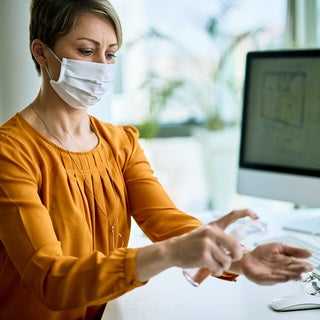4 health and safety considerations to make when returning to work after COVID-19
Tuesday June 2nd, 2020
Estimated time to read: 1 minute, 45 seconds

Extract: As businesses reopen their doors, there are numerous considerations to make to ensure a safe working environment for employees.leadership.
Guidelines for lifting lockdown orders have been issued, giving companies a look into what reopening their offices might look like.
However, for many companies, there are still a lot of considerations to make and planning to do before employees return to offices. A survey conducted by law firm Blank Rome found that nearly three-fourths of employers who responded have yet to create a return-to-work strategy.
Employers and businesses can help to slow the spread of disease in the workplace by taking precautionary measures.
1. Prevent spread of illness
Preventing the spread of illness in your workplace should be a top priority. To do this, the Centers for Disease Control & Prevention recommends:
- Encouraging workers who are sick to stay home.
- Separating symptomatic workers immediately, then sending them home.
- Conducting health checks before workers enter a building.
Health checks could be temperature readings or screening for symptoms, and should be done while adhering to social distancing measures. They should also be as private as possible to maintain employees’ confidentiality.
2. Provide protective equipment
Healthy workers returning to work should have adequate protection against disease. This means using protective gear, including face masks, gloves and/or coverings for clothing.
Blank Rome’s survey found that 64% of respondents plan on providing masks for their employees, and 38% will provide gloves. Fewer than 10% said they don’t plan on providing any protective gear, expecting that employees will obtain their own.
Employers might consider providing adequate PPE for employees as a way to ensure workers have the essential coverings they need, and to assure them that the office is a clean, healthy place.
Stocking up on hand sanitizer and soap are also smart ideas for ensuring employees are healthy and safe.
3. Maintain social distancing
During the beginning phases of returning to work, employees should continue to practice social distancing. Depending on the nature and layout of the workspace, this might mean reconfiguring cubicles, restricting access to every other desk or spacing out workstations.
As employers are well aware, co-workers may congregate in multiple spaces throughout a facility. Identify high-traffic areas where social distancing practices may be more difficult to maintain, and either close them off or make an effort to enforce these guidelines.
4. Continue remote work options
Each of these measures can reduce the risk of spreading illness, but staying at home remains the best way to avoid disease. Plus, many companies have found that their workforce is capable of conducting business from their homes.
According to Blank Rome’s survey, 82.76% of respondents said they’re more open to increasing remote work options as a result of this pandemic. For some companies, it may make sense to continue allowing employees to work remotely.
Even after the pandemic is over, employers have a responsibility to provide their employees safe atmospheres to work in. Taking these precautions can go a long way to prevent the spread of disease.
Visit www.isolvedhcm.com/covid-19 to view additional resources for safely bringing employees back to work, as well as to download our return-to-work toolkit. Our People Services team is also available to answer specific questions related to the situation.
